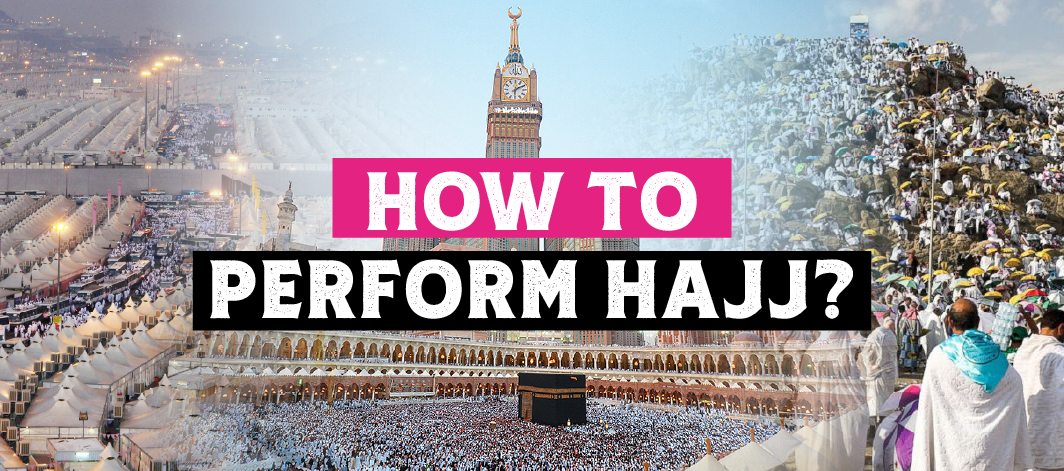Hajj occurs in Dhul Hijjah, the 12th month of the Islamic calendar. It is an annual spiritual experience undertaken by Muslims at least once in their lifetime. It is a way for us to show our submission and faith in our almighty creator, Allah (SWT).
With millions congregating each year in the holy city of Makkah for the annual Hajj pilgrimage, it’s easy to feel a little lost and overwhelmed. Fortunately, this complete Hajj guide will give you a brief overview of what you need to know about how Hajj is performed.
What is Hajj?
Hajj is the Pillar of Islam that refers to the pilgrimage every Muslim is expected to do at least once in their lifetime, so long as they’re financially and physically able to do so.
Each year, more than 3 million Muslims from all over the world congregate in Makkah to praise Allah (SWT) together, including 25,000 from the UK alone. This is the largest gathering of people in the world, with a crowd so big it would fill Wembley Stadium 40 times over.
Pilgrims travel to Makkah because this is where the Prophet Muhammad (PBUH) was born and where he received his first message from Allah (SWT). As a result, it’s such a holy site that only Muslims are allowed entry.
How Long is Hajj?
The annual Hajj pilgrimage takes place during the early part of the Islamic month of Dhul Hijjah. Muslims participate in Hajj between the 8th to 12th or 13th day of the month, meaning Hajj is performed over a period of five to six days.
The Significance of Hajj
Since Hajj is one of the five pillars of Islam, this pilgrimage holds an extremely important place in Islam. Among the blessings and rewards we receive from Allah, we also gain so many individual benefits that hundreds of pilgrims return home a changed person.
Purification of the soul
Hajj is believed to purify the soul and bring one closer to Allah. The rituals of Hajj involve a series of acts of worship, including prayers and fasting. By performing these acts, Muslims seek to strengthen their faith and devotion to Allah. Hajj is also an opportunity for Muslims to seek forgiveness for their sins and make a fresh start in their lives. The experience of Hajj is transformative, and Muslims often return home feeling renewed and spiritually refreshed.
Unity
Hajj is a reminder of the universal community of the Muslim Ummah. People from all over the world, regardless of their race, ethnicity, social status or gender, gather in Makkah to perform the same rituals. Hajj is a time for Muslims to come together and celebrate their shared faith and values. The experience of Hajj fosters a sense of unity and solidarity among Muslims, reinforcing the importance of compassion, cooperation and mutual respect.
Commemoration of Prophet Ibrahim and Prophet Muhammad
Hajj is a commemoration of the lives and teachings of Prophet Ibrahim (AS) and Prophet Muhammad (PBUH). Prophet Ibrahim (AS) is considered the father of all prophets in Islam and is revered for his faith and devotion to God. The rituals of Hajj, such as the sacrifice of an animal, are a reminder of Prophet Ibrahim's (AS) willingness to sacrifice his son Ismail (AS) in obedience to Allah. Hajj also commemorates Prophet Muhammad's (PBUH) performance of the pilgrimage and serves as a testament to his leadership and guidance for Muslims.
Renewal of faith
Hajj is usually a once-in-a-lifetime experience for most Muslims and is considered a great honour to perform. Many who perform Hajj return home with a renewed sense of purpose and a deeper understanding of their faith. The experience of Hajj is a reminder that life is a journey, and that the ultimate goal is to seek Allah's pleasure, guidance and forgiveness.
How to Perform Hajj
Hajj isn’t just a trip to Makkah for sightseeing. There are a range of sacred steps you need to take to complete your Hajj successfully. What follows are seven stages of performing Hajj. So, here's what you can expect from the pilgrimage.
What Are the 7 Steps of Hajj?
Step 1 – Enter Makkah and Perform the First Rituals
Intention and Ihram
When you arrive in Saudi Arabia for your Hajj, you should rectify your intention to do this solely for Allah’s pleasure.
When your intention is made, Muslim men must wear the Ihram – two white sheets; one worn around the waist and another worn around the shoulders.
Muslim women can wear any colour they like. They are only required to wear straight, loose dresses and ensure they’re covered to maintain respect.
With your Ihram on, you should start reciting Talbiyah, a prayer that shows your intention to perform Hajj for the glory of Allah (SWT):
لَبَّيْكَ اللَّهُمَّ لَبَّيْكَ، لَبَّيْكَ لَا شَرِيكَ لَكَ لَبَّيْكَ، انَّالْحَمْدَ، وَالنِّعْمَةَ، لَكَ وَالْمُلْكَ، لا شَرِيكَ لَكَ
"Labbayk Allaahumma labbayk, labbayk laa shareeka laka labbayk, ‘innal-hamda, wanni’mata, laka walmulk, laa shareeka laka."
"Ever at Your service, O Allah, ever at Your service. Ever at Your service, You have no partner, ever at Your service. Verily all praise, blessings and dominions are Yours. You have no partner."
When you recite Talbiyah, ensure you’re wearing your Ihram by the time you reach one of the five entry points to Miqat, the outer boundary of Makkah.
Once inside the walls of Makkah, Muslims make their way to the holy Kaaba, a cube-like building in the centre of the Great Mosque built by Ibrahim (AS) and his son, and the most sacred site in Islam. Here, they perform Tawaf.
What is Tawaf?
‘Tawaf’ comes from the Arabic taafa, which means ‘to walk around something’. Tawaf is the act of circling around the Kaaba anticlockwise seven times while reciting the takbir (Allahu Akbar). For this to be valid, you must be within the confines of the sacred mosque, Masjid al-Haram. This is done as part of Hajj, or even part of Umrah, the minor Islamic pilgrimage undertaken at any time throughout the year. Umrah rituals can be performed in the space of a few hours, but Hajj takes five or six days. Please note that menstruating women are not permitted to perform Tawaf as they are not in a state of ritual purity.
Completing Tawaf is seen as an act of devotion to bring you closer to Allah (SWT), demonstrating the unity of Allah’s believers and the commitment to tawheed, the oneness of Allah (SWT).
While performing Tawaf, Muslims pay special attention to the Hajr el Aswad, or the Black Stone, on the eastern corner of the holy Kaaba. The Black Stone was brought from heaven by the Angel Jibreel to complete the building of the Kaaba. Originally a pure white stone, it’s said that it was turned black due to the sins of mankind. However, touching the Hajr e Aswad can be atonement for one’s sins.
Sa’ee
Before moving on to the next stage, many Muslims perform Sa’ee, another ritual pilgrimage that can be performed during Umrah too.
Sa’ee refers to walking – or even running! – between two mountains in tribute to Hajar (AS), Ibrahim’s wife, after he left her in the valley as commanded by Allah (SWT). Desperate for water for her and her son Ismail (AS), Hajar (AS) ran between the Safa and Marwa hills seven times in blistering heat until the Angel Jibreel (AS) provided a spring in the ground.
The Sa’ee is part of the Hajj to commemorate Hajar’s (AS) search for water and Allah’s (SWT) resulting mercy. Fortunately, this is no longer done in the scorching heat, but instead through air-conditioned tunnels.
Step 2 – Mina, City of Tents
Muslims don’t stay in Makkah for all of Hajj’sobligatory rituals. Instead, pilgrims stay at Mina, a small town five to six kilometres from Makkah. There, pilgrims pray all five daily prayers, as well as non-compulsory prayers.
Although known as the City of Tents, rest assured that all the essential modern amenities you would hope for are there to use.
Step 3 – Day of Arafah
On the second day of Hajj (the 9th day of Dhul Hijjah), pilgrims head to Mount Arafat for the Day of Arafah, the holiest day in the Islamic calendar. This is the location of Jabal al-Rahmah, Mount Mercy, said to be where the beloved Prophet Muhammad (PBUH) delivered his final sermon.
One lesser-known fact about the day of Arafah is that it is sunnah to fast on this day. The Prophet Muhammad (PBUH) said that if you fast on this day, Allah (SWT) will forgive both the sins you have committed in the last year and the sins you will commit in the following year.
Throughout their journey to Arafat, they continue to recite the Talbiyah. Once they have arrived at the mount of Arafat, Muslims perform one of the most important part of the Hajj rites: Wuquf. This refers to standing on their feet before Allah (SWT) until sunset. There, they pray, repent and listen to soul-enriching sermons.
Step 4 – Muzdalifah
After performing maghrib prayers at sunset on Mount Arafat, pilgrims continue their blessed journey. On the way back to Mina from Arafat, pilgrims stop off at the small town of Muzdalifah.
Here, they perform Maghrib and Isha prayers before gathering pebbles for the following day and sleeping under the open sky.
Step 5 – Rami al-Jamarat (Stoning the Devil)
The third day of Hajj (Qurbani/ Udhiya Day) starts with prayers at Muzdalifa before pilgrims make their way back to Mina. Back at Mina, pilgrims perform Rami al-Jamarat, also known as the ‘stoning of the devil’. This involves throwing seven stones at Jamraat al-Aqabah, the largest of three pillars that represent the Devil.
This stoning ritual is one of the obligatory acts of Hajj. It commemorates the time in which the Devil attempted to make the Prophet Ibrahim (AS) turn his back to Allah (SWT), to which Ibrahim threw pebbles at him.
This continues from noon to sunset for the next two days. However, on the latter two days, pilgrims throw seven pebbles at all three of the pillars.
Step 6 – Eid al-Adha and Nahr (Animal Sacrifices)
The third day of Hajj is also the 10th day of Dhul Hijjah which starts the four-day festival of Eid al-Adha.
Pilgrims perform animal sacrifices, using either camels or lambs as the sacrificial animal. Although some sacrifice animals themselves, nowadays many opt for buying a sacrifice voucher before Hajj, allowing professionals to slaughter the animal on their behalf on the correct day. A share of the meat is then distributed to the needy, ensuring every Muslim around the world can eat.
Eid al-Adha commemorates when the Prophet Ibrahim (AS) was willing to sacrifice his son Ismail (AS) to show his devotion to Allah (SWT), before the Angel Jibreel (AS) provided a lamb to kill instead.
After the sacrifice, pilgrims go one step closer to show their devotion by shaving their hair, known in Arabic as Halak. Although women aren’t permitted to do the same, they still cut a lock of hair off as well.
Step 7 – Farewell Tawaf
Before leaving Makkah on the 12th or 13th day of Dhul Hijjah, pilgrims perform a final Tawaf. This one is known as ‘Tawaf al-Wadaa’, taken from the Arabic for ‘to bid farewell or say goodbye’. Once more, pilgrims circle the holy Kaaba anti-clockwise seven times to complete their Hajj pilgrimage before heading home.
Hajj is the final but most sacred Pillar of Islam. Millions of Muslims from all over the world congregate in Makkah for a series of rituals and prayers to show their devotion to Allah (SWT). Although it's a busy and taxing experience, it’s a sacred and spiritual journey that stays with Muslims for the rest of their lives.








